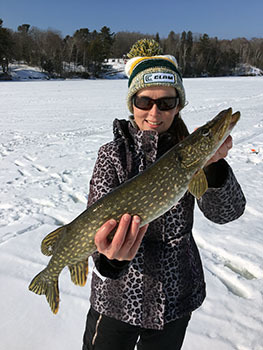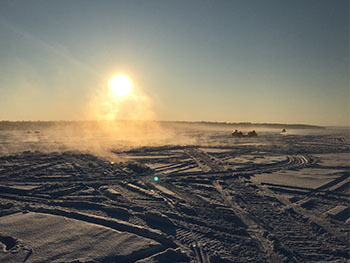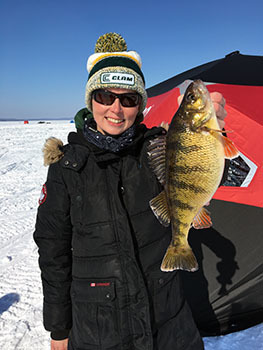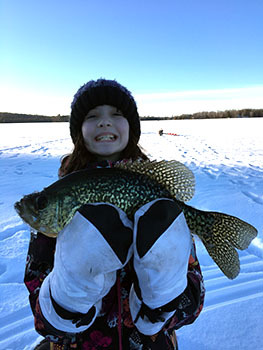Heading out to new ice fishing waters
By JENNIFER JOHNSON
Michigan Department of Natural Resources
In Michigan, we are lucky to have 11,000 inland lakes to enjoy. Whether we fish, swim or boat, we have plenty of options.
With that being said, we can easily slip into our familiar routines and keep to the lakes we know – going to the same lake, at the same spot and using the same gear.
This is very tempting, and admittedly I often do that. With the everyday demands of life – working full time, managing a household and balancing my family’s activities – squeezing in a quick afternoon of ice fishing often can be done only at my usual lakes.

Venturing out to new places can feel like a gamble.
I often read on ice-fishing social media groups, “I live in Houghton in Houghton County, is it worth the three-hour drive to the Bays de Noc in Delta County?” Of course, the answer is “yes!” But to go all that way and not catch fish can be disheartening and discourage the angler the next time they want to branch out to new ice-fishing spots.
To fish a new lake, there are a few options an angler can try.
The first approach is to reach out to friends who live out of town and meet them at their favorite lake. There are multiple benefits to this approach.
Putting this idea to work, obviously, you get to visit friends you may not have seen in a while. Additionally, they will know the lake already – where the deep spots are, where the structure is and places on the lake to avoid (e.g. inlets and outlets where the ice may be thinner). Maybe they know which bait works best (wigglers versus waxworms).
|

My husband and I have good friends that live in Alger County, and we recently went to Au Train Lake. I ended up catching a nice 25-inch northern pike off a tip-up and numerous yellow perch (on the small side but still fun to catch).
The second approach to finding new hard water to test is to see if there is a guiding service available for hire. This works very well if you are planning a big trip on a lake you’ve always wanted to fish, or if you have a short amount of time to explore the body of water. It’s the guide’s job to know the lake and to provide you with a great fishing experience.
My husband and I recently did this on Lake Gogebic in Ontonagon and Gogebic counties. I’ve long wanted to ice fish for the infamous “jumbo perch” on Lake Gogebic, but we were limited on the amount of time we had to go over there to fish.
The guide we hired knew exactly where to go, and which bait and techniques to use. We had such a good time, caught the jumbo perch we wanted, and I would certainly go back there.
|

The third approach is to venture out on your own. This has the most prep work involved but can pay off in dividends in the end. Here are some tips that can increase your chance of a successful angling trip on a new waterbody.
If you don’t have a specific lake in mind, first think about how far you are willing to drive and which types of fish you want to target. The answers to those two questions should narrow your choices to a more manageable level.
There are many ways to get information on a specific lake:
- The Michigan Department of Natural Resources fish stocking database includes information on fish the DNR has stocked dating back to 1979. Anglers can search by county, waterbody and species.
- The DNR weekly fishing report provides fishing conditions for numerous bodies of water across the state.
- Inland lake maps that provide depth contours and habitat characteristics are an essential component in learning about a lake. The DNR makes many lake maps available to the public.
- Contact your local DNR fisheries biologists and ask them for lakes to target and winter access.
- Contact local bait shops. They can provide valuable information on area lakes.
- Online forums and social media groups are often a bit secretive about providing details on good fishing locations, but they can be really good sources to ask about current local ice conditions.
Once you pick the lake, make sure to have a plan for the day. Tell someone where you are going and when you expect to be back home. It’s always recommended to bring another fishing partner with you, especially when going to a new lake.
|

Safety should always be the number one priority, so bring along a rope and ice picks in case you or someone in your party falls through the ice. Having a winter emergency pack that includes a change of warm, dry clothes is important too. Find more safety tips at Michigan.gov/IceSafety.
Make sure all your gear is in working condition. The last thing you want is for your auger to not run once you get to the lake. I also bring multiple tip-ups and fishing poles. Prepare for worst-case scenarios with your gear. With use over time, something will eventually break, and it’s usually not in the comfort of your home when it does.
Before heading to the lake, be sure to stop at the local bait shop you called earlier for any supplies or bait you may need.
Even on the lake you always go to, try a new location, bait or time of day.
Earlier this winter, my daughter Rhiannon told me she was “getting bored” going to the same spot on Sawyer Lake in Dickinson County. So, the next time we went out, we tried a location completely across from where we typically go.
It certainly paid off, because Rhiannon ended up catching a 14-inch black crappie that day. She and my son, Xander, each caught pike, so our “gamble” paid off.
If you feel your ice fishing lately has gotten into a rut or too much of a routine, remember in Michigan we have 11,000 inland lakes out there waiting to be explored.
Whether you reach out to friends or a guide or decide to venture out on your own, make sure to take advantage of these opportunities and explore new waters.
|
Check out previous Showcasing the DNR stories in our archive at Michigan.gov/DNRStories. To subscribe to upcoming Showcasing articles, sign up for free email delivery at Michigan.gov/DNR.
/Note to editors: Contact: John Pepin, Showcasing the DNR series editor, 906-226-1352. Accompanying photos and a text-only version of this story are available below for download. Caption information follows. Credit Michigan Department of Natural Resources, unless otherwise noted.
Text-only version of this story.
Couple: Jennifer Johnson, a Michigan Department of Natural Resources fisheries biologist and author of this story, is shown with her husband, Andrew Johnson, showing off their yellow perch from Lake Gogebic.
Crappie-1: Rhiannon Johnson is shown holding a 14-inch black crappie from Sawyer Lake in Dickinson County.
Crappie-2: Jennifer Johnson, a Michigan Department of Natural Resources fisheries biologist and author of this story, is shown with her daughter, Rhiannon, and a 14-inch black crappie Rhiannon caught in Sawyer Lake in Dickinson County.
Morning: A cold morning on Lake Gogebic is shown. Jennifer Johnson, a Michigan Department of Natural Resources fisheries biologist and author of this story, took this photo when it was -15 degrees, and the slush was causing mist to rise from the lake because it was so cold.
Perch-1 and Perch-2: Jennifer Johnson, a Michigan Department of Natural Resources fisheries biologist and author of this story, is shown holding a yellow perch from Lake Gogebic in the western Upper Peninsula.
Pike: Jennifer Johnson, a Michigan Department of Natural Resources fisheries biologist and author of this story, is shown with a northern pike she caught while ice fishing on AuTrain Lake in Alger County./
|